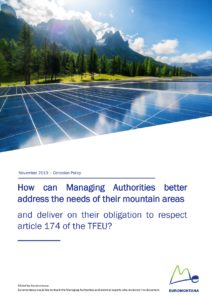The Directorate-General for Regional and Urban Policy (DG REGIO) recently launched a new online tool to identify territorial strategies implemented in the European Union.
Get inspired by other mountainous territories’ strategies
The interactive map guides you throughout the different territorial tools available for Managing Authorities and citizens that are currently being implemented in the EU, such as Operational Programmes, Integrated Territorial Investments (ITI), Community-Led Local Development Strategies (CLLD) and Priority Axis. The map also allows you to make a research by region, fund and thematic objective so that you can find relevant strategies and get inspired by some of these examples.
 The tool features some strategies focused on mountain areas, such as the CLLD Strategy 2014-2020 of the Ore Mountains Local Action Group in Czech Republic. It aims at identifying relevant projects to improve the quality of life, increase the economic growth and protect natural and cultural heritage in the Krušné Mountains. Another example is the Development strategy 2014-2020 “Innovative thinking in mountainous future areas for solidarity and sustainable growth“, implemented by the LAG Leader Sjö, Skog och Fjäll in the Northern-West mountainous part of Sweden. The objective is to improve the resilience of local businesses, increase innovation in the region and foster inclusion of everyone in the society. The map also shows a concentration of ITIs in Greece and Southern Italy.
The tool features some strategies focused on mountain areas, such as the CLLD Strategy 2014-2020 of the Ore Mountains Local Action Group in Czech Republic. It aims at identifying relevant projects to improve the quality of life, increase the economic growth and protect natural and cultural heritage in the Krušné Mountains. Another example is the Development strategy 2014-2020 “Innovative thinking in mountainous future areas for solidarity and sustainable growth“, implemented by the LAG Leader Sjö, Skog och Fjäll in the Northern-West mountainous part of Sweden. The objective is to improve the resilience of local businesses, increase innovation in the region and foster inclusion of everyone in the society. The map also shows a concentration of ITIs in Greece and Southern Italy.
How to consider mountain areas in the 2021-2027 programming period?
 Yet, as reminded by Marie Clotteau, Director of Euromontana, during the event “Europe Closer to citizens of Islands Mountains and Sparsely Populated Areas” organised on October 8, 2019, during the EU Regions Week, there is still a lack of knowledge on ITI and CLLD strategies at local and regional level. With only a few examples implemented in mountain areas, these new tools introduced in 2014 are still not used enough.
Yet, as reminded by Marie Clotteau, Director of Euromontana, during the event “Europe Closer to citizens of Islands Mountains and Sparsely Populated Areas” organised on October 8, 2019, during the EU Regions Week, there is still a lack of knowledge on ITI and CLLD strategies at local and regional level. With only a few examples implemented in mountain areas, these new tools introduced in 2014 are still not used enough.
The database, even though it still lacks details on each strategy for the moment, is thus a useful tool to map the different strategies implemented in mountain areas and can help disseminating knowledge on territorial development tools.
To encourage the implementation of these territorial strategies in mountain areas, you can also see Euromontana’s factsheet for Managing Authorities, which provides you with the keys for a more efficient programming for the 2021-2027 period.
26 March 2020









